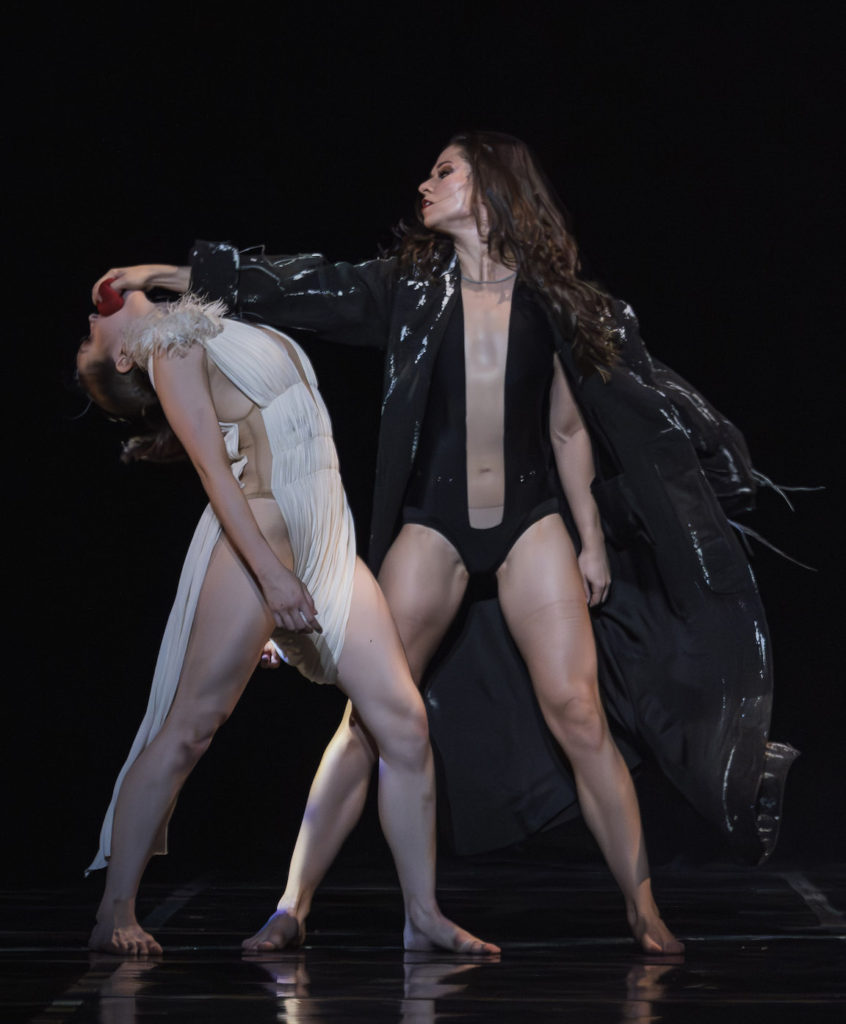The Royal Winnipeg Ballet: A mature, haute couture Snow White - Vancouver Ballet Society
- Home
- Reviews 2020 - 2023
- The Royal Winnipeg Ballet: A mature, haute couture Snow White

By Holly Harris
The Royal Winnipeg Ballet took a deep dark dive into a classic Brothers Grimm fairytale as it launched its 84th season with the Canadian debut of Angelin Preljocaj’s inky black Snow White. The 105-minute (with no intermission) narrative ballet had its world premiere by the French choreographer’s own company in 2008, with the Winnipeg production held September 28-October 1, staged by former Ballet Preljocaj dancer Claudia De Smet.
Originally slated for fall 2020, postponed due to the pandemic, the contemporary work has been on artistic director and CEO André Lewis’ bucket list for years. The RWB’s current Living the Dream season is intended to celebrate the upcoming 50-year legacy of Lewis, who steps down from the company in spring 2025.

In the centuries-old hierarchical ballet world, it’s always refreshing to see lesser-known dancers emerge from the ranks to shine in plum roles (all lead roles were alternating). The company currently has only two female principal dancers in its roster, the upside of which is that it gives opportunities for younger artists. Toronto’s Taisi Tollasepp, 19, an RWB School Professional Division graduate performing her first major role as Snow White, shows great promise, having entered the corps de ballet after joining the company earlier this season as an apprentice.
Dressed in French fashion icon Jean Paul Gaultier’s voluminous haute couture costume — equal parts Greco-Roman tunic and saggy diaper — Tollasepp crafted a flesh-and-blood heroine, capturing Snow White’s girlish innocence as well as a smouldering sensuality as she falls in love with corps member Logan Savard’s stately Prince. Each of their three pas de deux showcased the couple’s simpatico artistry.

It’s no small feat for ballet dancers to perform without protective pointe shoes or soft slippers, with many cast members, including Snow White, dancing barefoot. This artistic choice further heightened the show’s intimacy and contemporary ethos, as bare skin slapped against the stage floor.
Soloist Jaimi Deleau stole the limelight every time she burst onstage as the narcissistic, vainglorious Queen, deeply resentful of her stepdaughter after her gilded mirror magically reflects Snow White as “the fairest of them all.” Decked out in S&M-flavoured stiletto boots, slinky black gloves, and bodysuit, Deleau transformed from her past portrayals of pristine fairy godmothers into a dominatrix-styled wildcat, becoming ostensibly the ballet’s central character. The Queen’s final, flailing solo, as she dances to her death during the wedding scene, will not soon be forgotten. Nor will her savage pas de deux with Snow White as she shoves the apple down her stepdaughter’s throat.
Another jaw-dropping scene comes as the Seven Monks, recalling the fairytale’s original “dwarves,” clamber out of mining shafts in French set designer Thierry Leproust’s towering 7.5 metres-tall wall. Their graceful aerial dance suspended by bungee-type wires, in which the dancers perform acrobatic flips and spins, adds wow factor, providing a welcome counterbalance to the slow-paced, often ponderous ballet’s weightiness.

Several overly extended scenes, such as the Monks’ playful stomping and clapping games with Snow White, or the Courtesans’ performing for what feels an eternity for corps member Tymin Keown’s King and his royal daughter, Snow White, add little to the narrative thrust. A ballet — even a dark one — still needs to connect on an emotional, human level, and at times these scenes felt gratuitous.
There is an abundance of unison movement in Preljocaj’s intricate lexicon of angular, gestural movement, including body isolations, hip swivels, whipping kicks, and fluid lifts. Characters are clearly differentiated, however; for instance, Snow White’s gorgeously lyrical lines are contrasted by the Queen’s sharp attack.
One stunning solo arrives with principal Alanna McAdie’s heavily antlered Deer, ultimately killed by the trio of Hunters who rip out its heart in order to trick the Queen into believing Snow White is dead. The chameleonic dancer’s crisply executed, staccato movement added mystery and magic to the opening night performance.
Another stunner is the deeply moving scene in which Snow White’s Mother (second soloist Katie Bonnell), who died in childbirth during the ballet’s prologue, “flies” in high above the stage to comfort her daughter lying atop the glass coffin.
The Winnipeg Symphony Orchestra, beautifully led by Julian Pellicano, performed the all-Mahler pastiche score, interlaced by buzzing electro-acoustic soundscapes. The production also features shadowy lighting by Scott Henderson, based on Patrick Riou’s original design, which adds dramatic intensity throughout.
As arts groups continue to rebuild after COVID, many have opted for safer programming choices to lure skittish audiences back into concert halls. This is not one of them. Kudos to Lewis for taking a risk with Preljocaj’s bold and often brutal Snow White, which shows another side of the long cherished fairytale, and packs a punch.
Snow White tours to Ottawa’s National Arts Centre in April 2024.

